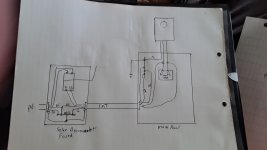Fred B
Senior Member
- Location
- Upstate, NY
- Occupation
- Electrician
Question,
I've attached a drawing (I'm not an artist) of an installation of a solar system that doesn't seem right. It has N/G bonded in 2 spots, at the PV disconnect and the main house panel. Plus grounding and grounded conductors running between both panels, plus the EMT bonded. It has a supply side Polaris connection for the pv feeders and the disconnect is fused.
Is this code compliant? What code section allows the bonding of N/G in 2 locations?
NYSERTA claims this is how they want it done but unable to substantiate it with a code reference? What am I missing in the code? (2017)

I've attached a drawing (I'm not an artist) of an installation of a solar system that doesn't seem right. It has N/G bonded in 2 spots, at the PV disconnect and the main house panel. Plus grounding and grounded conductors running between both panels, plus the EMT bonded. It has a supply side Polaris connection for the pv feeders and the disconnect is fused.
Is this code compliant? What code section allows the bonding of N/G in 2 locations?
NYSERTA claims this is how they want it done but unable to substantiate it with a code reference? What am I missing in the code? (2017)


